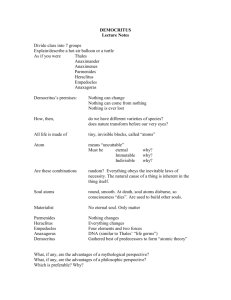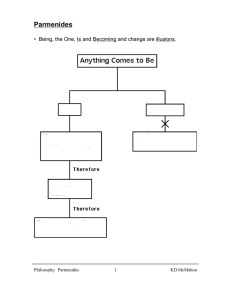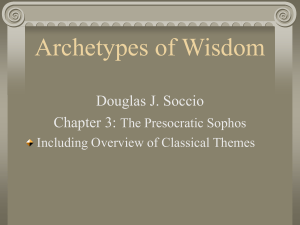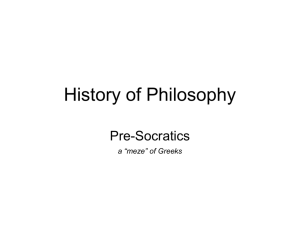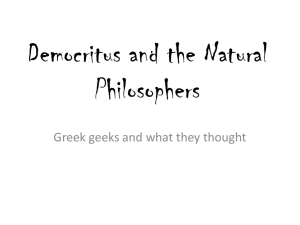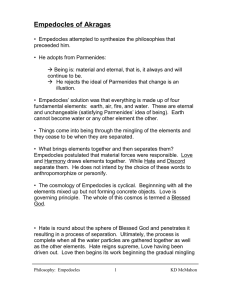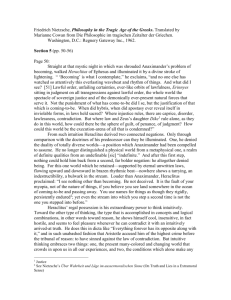The Problem of Permanence and Change:
advertisement
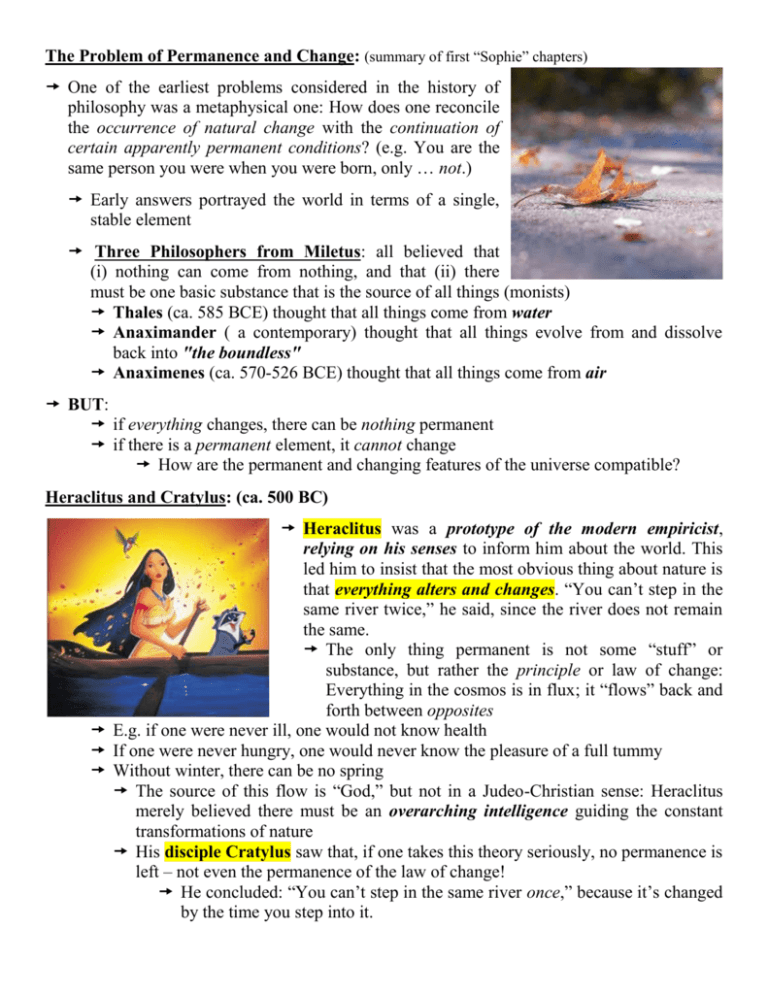
The Problem of Permanence and Change: (summary of first “Sophie” chapters) One of the earliest problems considered in the history of philosophy was a metaphysical one: How does one reconcile the occurrence of natural change with the continuation of certain apparently permanent conditions? (e.g. You are the same person you were when you were born, only … not.) Early answers portrayed the world in terms of a single, stable element Three Philosophers from Miletus: all believed that (i) nothing can come from nothing, and that (ii) there must be one basic substance that is the source of all things (monists) Thales (ca. 585 BCE) thought that all things come from water Anaximander ( a contemporary) thought that all things evolve from and dissolve back into "the boundless" Anaximenes (ca. 570-526 BCE) thought that all things come from air BUT: if everything changes, there can be nothing permanent if there is a permanent element, it cannot change How are the permanent and changing features of the universe compatible? Heraclitus and Cratylus: (ca. 500 BC) Heraclitus was a prototype of the modern empiricist, relying on his senses to inform him about the world. This led him to insist that the most obvious thing about nature is that everything alters and changes. “You can’t step in the same river twice,” he said, since the river does not remain the same. The only thing permanent is not some “stuff” or substance, but rather the principle or law of change: Everything in the cosmos is in flux; it “flows” back and forth between opposites E.g. if one were never ill, one would not know health If one were never hungry, one would never know the pleasure of a full tummy Without winter, there can be no spring The source of this flow is “God,” but not in a Judeo-Christian sense: Heraclitus merely believed there must be an overarching intelligence guiding the constant transformations of nature His disciple Cratylus saw that, if one takes this theory seriously, no permanence is left – not even the permanence of the law of change! He concluded: “You can’t step in the same river once,” because it’s changed by the time you step into it. Question: How is communication possible in Cratylus’ view of the world? Or is it? Parmenides and Zeno: Parmenides was a prototype of the modern rationalist, and tried to understand all that is using reason alone; sensory evidence is too unreliable and subjective to lead to truth. A contemporary of Heraclitus, Parmenides believed that everything which exists has always existed; everything in the world is everlasting “Nothing comes from nothing,” he thought, “and nothing that exists can come from nothing.” He took this idea further and argued that nothing ever changes; nothing can become anything other than it is When his senses told him this was obviously not true, he refused to accept it, and chose instead what his reason told him must be the case Parmenides’ disciple Zeno is famous for inventing paradoxes of motion which explore the puzzling relationships that exist between space and time, to show the truth of Parmenides’ ideas E.g. if Achilles, the fastest runner in the Greek army, gives a tortoise a head-start in a foot race, he can never catch up to it and win; he will get halfway to it, and then halfway again, and so on, and so on … Empedocles: tried to resolve the opposition between Heraclitus and Parmenides saw that the problem was in the assumption of only one basic element – no one thing alone can explain the reality of change obvious to our senses he believed that there were four roots or basic elements: earth, air, fire, and water all natural processes were due to the coming together or separation of these four elements – all things are a mixture of these elements in varying proportions e.g. when a living thing dies, the four elements separate again – these changes are visible to the eye; but the elements themselves are everlasting; i.e. permanence and change are both explained may have deduced this from, say, observing a piece of burning wood nothing really changes except the proportion of each element in the mix Empedocles added another important dimension to metaphysical thought: the idea of force He believed that there were two forces at work in nature, bringing elements together or driving them apart He called these “love” and “strife” This distinction between substance and force is one we still use in science today he also believed that it was because we are composed of the four roots that we can perceive nature because my eyes are composed of earth, air, fire, and water, I can see a flower (earth), clouds (air), the sun (fire), and the river (water). If I lacked any of these elements, I would lack the capacity to perceive all of nature Anaxagoras built on this last idea, and argued that nature is built up of an infinite number of minute particles, invisible to the eye, in which each particle has fragments of all other things in it – he called these “seeds”, and believed they were organized by an intelligent force he called “nous” He meant this quite literally; i.e. milk has bits of skin and bone in it, & so can nourish us It is vaguely like our understanding of living cells; the smallest skin cell I have, for example, contains the genetic code which determines every other organ in my being Question: Why is Lego the most ingenious toy in the world? Democritus built on the ideas of Empedocles and Anaxagoras believed nature was built of tiny, everlasting, unbreakable bits he called “atoms” (meaning uncuttable) there must be something unbreakable at the base of all matter, or everything might just melt into some kind of cosmic soup there is an infinite variety of kinds of atoms, some round & smooth, some irregular & jagged, etc.; all of them are eternal, because (again) “nothing comes from nothing” because they are so different, atoms when joined together can make an infinite variety of different bodies when a body dies, the atoms separate and move around in space until they recombine in a new body they are able to combine and recombine because they all have “hooks” and “barbs” that enable them to connect with other atoms (like Legos) the atoms don’t change, but their position relative to others – the way they combine – does permanence & change explained: Q.E.D.! D. did not believe there was some cosmic “force” or “intelligence” driving all this; he was a strict materialist who believed that atoms were all that existed, and that they combined and recombined simply because it was their nature to do so – it all happens quite mechanically this is a remarkable anticipation of modern atomic theory
